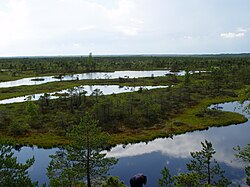Ķemeri National Park (Latvian: Ķemeru nacionālais parks) is a national park west of the city of Jūrmala, Latvia. The territory of the park is mostly occupied by forests and mires, the most significant of them being the Great Ķemeri Bog (Latvian: Lielais Ķemeru tīrelis). There are also several lakes, that are former lagoons of the Littorina Sea. Lake Kaņieris is a Ramsar site.
Understand
[edit]
Established in 1997, Ķemeri National Park is the third largest national park in Latvia by area, covering an area of 381.65 km2. The park protects the famous natural mineral-springs and muds, used for centuries because of their therapeutic nature. The springs led to development of many resorts, spas, and sanitariums in the 19th century.
Ķemeri National Park has many natural sulfur springs, due to its sublayer of gypsum and soil bacteria (Desulfovibrio desulfuricans), forming H2S gas which easily dissolves in the water. The therapeutic mineral waters and muds found in Ķemeri are used in health resorts in Ķemeri town, used to treat mostly digestive system and skin problems.
- Park website. (in Latvian).
- Park visitors’ centre, in the Forest House (2 km from Kemeri), ☏ +371 67730078. open from May 1 to September 30. Information available in English, and accessible to visitors in wheelchairs.
History
[edit]Formation of bogs in Latvia started in the postglacial period, approximately 10,000 years ago as the climate became warmer and more humid. Thus allowing Sapropelic mud formation at the bottom of the lake, consisting of sandy soil and the remains of water plants and animals.
Numerous tanks from World War II were swallowed into the bog, due to depths reaching up to two stories.
Landscape
[edit]Forests occupy 57% of the total area of the park. Bogs occupy 24% of the total area of Ķemeri National Park. All three wetland types are found here – fens, transition and raised bogs. Lielais Ķemeru tīrelis bog is an internationally important wetland.
Flora and fauna
[edit]Many species of plants thrive in the bog, especially mosses and orchids. Meadows – both dry and wet – occupy 6% of the territory. Water in the form of lakes, rivers, sulphur springs and sea occupy 10% of the park's territory. Many of the out flowing streams have been altered over history to drain the marshland for agriculture, however the waters still support a wide variety of rare species, such as native snails and mussels, fishers, storks and otters.
The bog also contains edible wild berries such as cranberries, crowberries, cloudberries and blueberries.
Raised bog is not rich in diversity of plants due to the harsh conditions created by the bog such as low nutrient content and low oxygen content. Thus, the flora is specifically adapted to these conditions.
The bog is home for a number of Latvian bird species, such as the Common crane, Wood Sandpiper and European Golden Plover. The latter two species only breeding habitat is the raised bog.
Climate
[edit]Most of the time, the climate is the typical Latvian climate. Bring a jacket with you unless you're going in summer.
Talk
[edit]Generally, most people in Ķemeri National Park can speak English and Latvian, but some can also speak German, Estonian, Russian or Lithuanian.
Get in
[edit]The park is 11 km west of Jūrmala on the A10 road — about a 2 hr 15 min walk.
Fees and permits
[edit]Get around
[edit]The P128 road gets through parts of this route. Other parts can only be reached by foot.
See
[edit]- Kanieris Hill Fort. A fort near Lake Kanieris and is accessible via the Kanieris Hill Fort Trail.
- 1 Lake Kanieris. Birdwatching venue.



- Green Dune. Once part of the Littorina Sea shores, it is now a sand dune, several kilometres long.
Do
[edit]
- 1 The Great Ķemeri Moorland (inside Ķemeri National Park) (Lielais Ķemeru tīrelis), Slampes pagasts (there are frequent train connections towards Tukums with a stop in Ķemeri village, right in the middle of the Moorland; also, the major "highway" going east towards Tukums and Ventspils goes right through the Moorland), ☏ +371 67730078, [email protected]. Head south, and you will find a trail made of planks across the swamp including an 2 observation tower (but without a roof, so not good for overnighting without a tent)—see included track in the following. It seems that (from the satellite view) starting from the observation tower (popular with photographers for sunrise and sunset scenes), there is a trail leading even further south into the swamp, probably requiring rubber boots – check out the trail, also included with this listing. Nevertheless, also northwest of Ķemeri village trails lead through the swamp, check them out on OpenStreetMap, which many mobile Apps like OsmAnd or Mapy.cz, etc. use, or any other preferred map.



- The Great Ķemeri Moorland Trail (green). Distance: 11.24 km. 3–4 hr. Grade: easy. The trail starts and finishes at the Ķemeri village railway station. Download coordinates: GPX, KML.
- Ķemeri Moorland (further into the swamp) Trail (red). Distance: 1 km. 1/2 hr. Grade: medium. Waterproof boots recommended. Start at the observation tower, from there the trail seems clearly visible. Note that this is a swamp with its common dangers, take precaution and do not walk on your own. Download coordinates: GPX, KML.
Buy
[edit]- Ragaciems Market. Known for its smoked fish.
Eat
[edit]- 1 Vēsumiņš, Tūristu iela 5, Jūrmala. 11:00-20:00. Ice cream shop.



Drink
[edit]Sleep
[edit]- 1 Hotel Kemeri, Tukuma iela 2, Jūrmala, ☏ +371 28 308 055, [email protected]. Check-in: 15:00. Historic hotel. Includes jacuzzi (hot tub) and sauna.



Stay safe
[edit]The speed limits in the park are mostly 70 km/h but can rapidly drop to 30 km/h within seconds notice. The roads and the boardwalks may be slightly slippery after rain.
Go next
[edit]- Explore the rest of the Riga region

